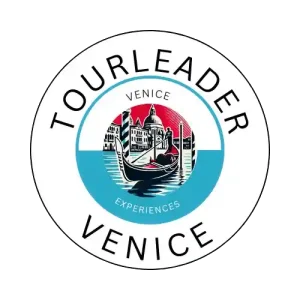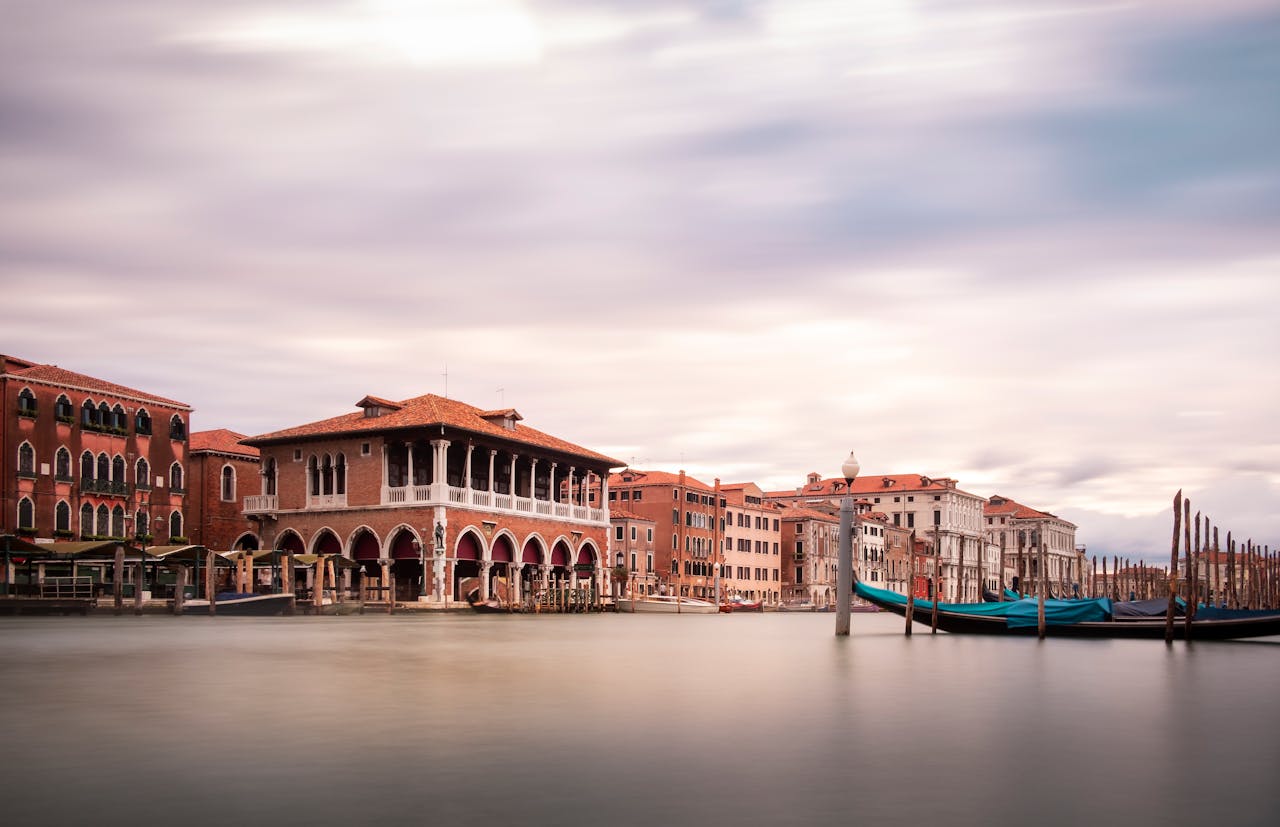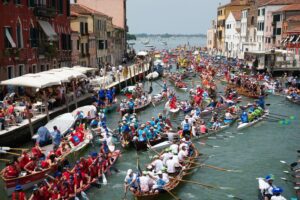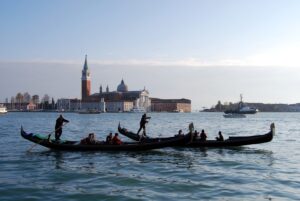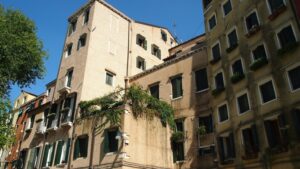Does Venice Experience Flooding? Understanding “Acqua Alta” and How to Travel Smart
Venice has always danced with the sea — sometimes gracefully, sometimes against the tide. 🌧️ If you’ve seen those dramatic photos of acqua alta (high water) covering St Mark’s Square, you might wonder: “Does Venice still flood?” “Should I worry about it when I visit?”
The short answer: Yes, Venice still experiences high tides — but thanks to new technology and centuries of adaptation, the city is safer, drier, and more welcoming than ever. Here’s the insider guide to understanding what really happens when the lagoon rises — and how to enjoy your trip with confidence (and dry feet!).
🌍 What Exactly Is “Acqua Alta”?
Acqua alta literally means “high water.” It refers to the seasonal tide peaks that can temporarily flood low-lying areas — mostly St Mark’s Square, parts of Dorsoduro, and Rialto.
These events occur when:
- 🌕 The moon and sun align (spring or autumn tides)
- 💨 Strong scirocco or bora winds push Adriatic water into the lagoon
- 🌧️ Heavy rainfall adds pressure from rivers and canals
When all three align, the lagoon swells. But modern Venice doesn’t panic — it prepares. Wooden walkways appear, alarms sound gently through the city, and locals pull on waterproof boots with their morning espresso.
⚙️ How the MOSE Barriers Changed Everything
Until recently, flooding felt inevitable. Then came MOSE — the massive engineering system that now protects Venice from tides above 110 cm.
MOSE stands for Modulo Sperimentale Elettromeccanico — a series of 78 bright-yellow mobile barriers installed at the lagoon’s three inlets (Lido, Malamocco, and Chioggia). When high tides threaten, the barriers rise from the seabed, closing Venice off from the Adriatic in just 30 minutes.
Since its activation in 2020, MOSE has saved Venice dozens of times — including several “once-in-a-century” floods. Even during record tides in 2023, St Mark’s Square stayed dry for the first time in history.
💡 Good to know: The system is fully operational in 2025 and coordinated with real-time weather forecasting, meaning visitors can explore without the fear that once haunted November trips.
📅 When Does Flooding Usually Happen?
- 🍁 Most common months: October → December
- 🌸 Occasional: March–April
- ☀️ Rare: May–September
The acqua alta season coincides with autumn storms and winter tides. But thanks to MOSE, fewer than 10 days a year now see significant flooding — and most last only a few hours.
Curious about weather by month? Read our full Venice Weather Guide to pick the perfect time for your trip.
🏛️ How Venetians Live with the Lagoon
For locals, the lagoon isn’t an enemy — it’s family. Venetians have been managing water since the 5th century: raising pavements, waterproofing foundations, even adjusting building entrances to match the tides.
When the sirens sound, signaling the height of the expected tide, people don’t rush — they adapt. Shops set out metal barriers, cafés keep serving espresso, and the vaporetti continue their routes (with an extra splash).
Tip: During acqua alta, use the Vaporetto Pass to move comfortably between neighborhoods while raised walkways are in place.
🧭 What Visitors Actually Experience
Even if the tide rises, you’re unlikely to face drama. Here’s what happens:
- 📢 A siren or text alert announces predicted tide height.
- 🚶 Wooden walkways appear across major routes within an hour.
- 🛍️ Locals keep calm; shops stay open.
- 🌤️ Within 2–3 hours, the water retreats, leaving streets washed and gleaming.
The experience can even feel magical — reflections of palaces shimmering under early light, the city quietly reclaiming itself from the sea. For photographers, it’s Venice at her most poetic.
🩴 What to Pack if You Visit During Acqua Alta Season
- 🧥 Waterproof jacket or trench coat
- 👢 Foldable rubber boots (available everywhere in Venice)
- 🧦 Extra socks & quick-dry shoes
- 💼 Plastic bags to protect electronics
- 📱 Tide-forecast apps (try “Hi!Tide Venice” or “Centro Maree Venezia”)
Still want style with practicality? Venetians do it daily — chic raincoats, tall boots, and a spritz in hand. 🌂
💡 Local Secrets to Navigate Like a Pro
- 🔸 Follow the yellow arrows: “Per San Marco,” “Per Rialto,” etc. mark elevated routes.
- 🔸 Go high: Dorsoduro & Cannaregio flood least; Castello near the lagoon floods most.
- 🔸 Time your meals: Book lunch around high-tide windows; most tides peak mid-morning or evening.
- 🔸 Walkways first: Use raised paths — don’t wade unless locals do.
- 🔸 Embrace the moment: Some travelers plan visits during mild tides just for the unique atmosphere.
🌉 Is Venice Sinking?
Not exactly — at least, not dramatically. Venice naturally subsides 1–2 mm per year (normal for sediment islands), while global sea levels rise around 3 mm annually. MOSE and new ground-stabilization systems balance these effects, giving Venice decades — if not centuries — of life ahead.
What truly endangers Venice isn’t the water itself, but overtourism and economic pressure on residents. Learn how locals preserve their traditions on our Off-the-Beaten-Path Orientation Tour — a journey through neighborhoods tourists rarely see.
🕰️ Historic Floods That Shaped Venice
- November 4 1966 — The “Great Flood”: 194 cm tide submerged 80 % of the city. Led to global preservation efforts.
- November 12 2019 — 187 cm tide damaged hundreds of shops before MOSE activation. Catalyst for reform.
- December 2020 → Present — MOSE successes: every major tide controlled, proving the city can live safely with the sea.
Each event taught Venice to innovate — proof that resilience is built into her bricks.
🌅 What to Do When It Floods — Smart Traveler Tips
- ✅ Stay calm — locals do!
- 🕒 Adjust timing — sightseeing resumes within hours.
- 🛥️ Book indoor experiences: visit Murano Glass Workshops or Mask-Making Studios.
- 🎟️ Use skip-the-line tickets for Doge’s Palace or St Mark’s Basilica.
- 🍷 Take refuge like a Venetian — in a cozy bacaro with cicchetti and wine. Try our Cicchetti & Wine Tour for authentic warmth.
🌞 When Venice Shines Brightest
If you’d rather avoid any chance of flooding, plan for:
- 🌼 April → June — mild weather, long days, low tides
- ☀️ September → Early October — post-summer calm, stable lagoon levels
Check our Best Time to Visit Venice Guide for more detailed monthly insights.
🩵 Final Thought — Venice: Between Water and Wonder
Yes, Venice still meets the sea — but now on her own terms. What was once a struggle is now a rhythm; what was once fear has become fascination.
So pack your curiosity (and maybe waterproof boots), and come see the miracle of a city that refuses to sink — floating through centuries with grace, humor, and pride.
🌊 Explore Venice’s Lagoon with a Local Guide →
❓ FAQs About Flooding in Venice
Does Venice still flood today?
Yes, but far less than in the past. Thanks to the MOSE barriers, major floods are rare and usually short. Most visitors never experience significant acqua alta.
When is the acqua alta season?
Between October and December, occasionally in early spring. Even then, floods last only a few hours and are closely monitored with public alerts.
Should I avoid Venice during high-water months?
No. The city is well-prepared, hotels stay open, and walkways keep you dry. Traveling with a local guide like Tour Leader Venice ensures comfort and insider access whatever the tide.
